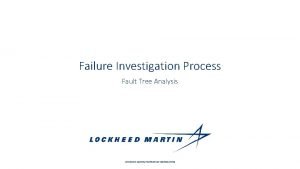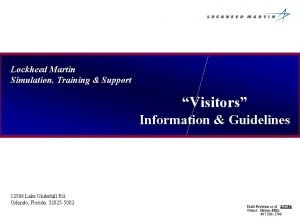Lockheed Martin Automatic Recognition Clinic Logan Greer ME

- Slides: 1

Lockheed Martin Automatic Recognition Clinic Logan Greer, ME • Eric Guidarelli, ECE • Joseph Mandara, ME • Craig Szot, ECE • Ric Rey Vergara, ECE • Ryan Wright, ECE Faculty Advisor: April Thompson-Tomlinson • Lockheed Martin Clinic Coordinator: Marc Greenberg Junior / Senior Engineering Clinic • Fall 2015 Rowan University College of Engineering | Glassboro, New Jersey Abstract The primary objective of this project was to gain a basic understanding of machine learning by studying neural networks and applying MATLAB’s Neural Network Toolbox to perform character recognition on a widely studied dataset of hand-written characters. After evaluating the results of various features and network configurations with ten-fold crossvalidation, an optimal network that combined distance profiles, projection histograms, and pixel features was selected. This network achieved a classification success of 88. 12% ± 2. 26% on all 62 characters, which is comparable to the reported successes of a convolution neural network and human classification. Neural Networks Artificial Neural Networks are problem solving models inspired by biological neural networks (i. e. a brain). They consist of many interconnected nodes, akin to neurons, that receive and pass forward information, potentially through multiple layers. A node can receive multiple data inputs, and from them produce a single output. Multiple nodes can be created in a layer to receive different inputs and make different “decisions. ” Creating additional layers of nodes allows outputs from the previous layer to be combined, which allows the network to view the data in more abstract ways [3]. x 1 x Objectives The objective of this project was to gain a basic understanding of machine learning in order to apply neural networks to a character recognition problem. To create a functional Neural Network, the project required students to gain a working knowledge of MATLAB’s Neural Network Toolbox. The project operated under an agile methodology in order to introduce engineering students to a project management system gaining increasing traction in industry. NIST Special Database 19 was acquired from the National Institute of Standards and Technology (NIST) for use in this project. This dataset contains 815, 000 written characters (0 -9, a-z, A-Z) acquired from 3, 600 different writers for use in character recognition. The characters were converted to 128 x 128 binary images via thresholding [1], and all excess white space surrounding each character was cropped. They were then resized to 16 x 16 binary images to reduce file size without removing useful information. 2 Single Node Network Profiling Features For this project, the network inputs were numerical features that describe the characters and help distinguish them from each other. The output targets were the 62 different character classes. Crossings Lines are drawn either horizontally or vertically through the character, and each transition from background to foreground is counted. Euler Number The Euler Number is calculated by subtracting the number of holes in a region from the number of objects in the region. Projection Histogram Projection histograms are generated by counting the number of pixels in each character row and column of a character image, and then projecting The number of black pixels in each area. Pixels NIST 19 Sample Handwriting Form [2] This profile involves simply using the binary value of each pixel as a unique feature (white = 1, 0 = black). Original Image Feature Network Configuration Classification Success Crossings [150, 110] 36. 59% ± 1. 17% Projection Histogram [100] 48. 17% ± 0. 74% Distance Profile [100, 100] 71. 46% ± 1. 47% Pixel [70, 70] 71. 59% ± 14. 49% Merged [90, 90] 81. 94% ± 2. 26% The optimal neural network utilized a combination of projection histograms, distance profiles, and individual pixels as features of interest. The success achieved by the merged network is comparable to the success of a convolution neural network committee (88. 12% ± 0. 09%) [4], and the success of actual human classification (81. 8% w/ 0. 1% standard error) [5]. All three of these studies were conducted using the full NIST Database. Most of the merged network’s incorrect classifications resulted from very similar characters that would require contextual information to correctly classify (e. g. {0, O, o}, {1, l, I, i}, {9, q}, {C, c}, etc. ). The optimal merged network was able to classify the character dataset with reasonable success. The network proved to be as accurate as human classifiers, and performed its task much faster than a human is capable of. A working knowledge of neural networks and their application through the use of MATLAB’s Neural Network Toolbox was gained by all involved with the project. The team also received exposure to the agile methodology and acquired proficiency with its application to engineering problems. Future work in character recognition includes investigating the potential merits of using a deep belief network with the same character database. The deep belief network will be created using Python and its Theano Library. References A distance profile counts the number of pixels (distance) from the bounding box of a character image to the outer edge of the character. Cropped and Resized Image Principal Component Analysis (PCA) was performed on the features to locate the eigenvectors that contribute the most to the overall variance of the data. The transformed data was used as the new features space. Ten-fold cross validation was performed on each feature network. Conclusions Distance Profile Original Image Results Binary Image [1] David (2013, April 8). “Exploring SD 19 Glyph Recognition With Random Forests”. Ascii Rain [Online]. Available: http: //asciirain. com/wordpress/2013/04/08/exploring-sd 19 -glyph-recognition-with-randomforests [Accessed: 24 September 2015] [2] P. Grother et al. , “NIST Special Database 19 Handprinted Forms and Character Database, ” NIST, 1995. [3] A. Thompson-Tomlinson, “Artificial Neural Networks, ” Rowan University, Glassboro, NJ, 2015. [4] D. C. Ciresan et al. , “Convolutional Neural Network Committees for Handwritten Character Classification, ” IDSIA, Manno-Lugano, Switzerland, 2011. [5] F. Bastien et al. , “Deep Self-Taught Learning for Handwritten Character Recognition, ” Dept. IRO, Montreal, Canada, 2010.

